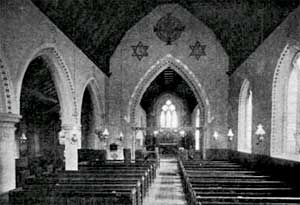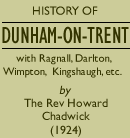< Previous | Contents | Next >
THE CHURCH

DUNHAM CHURCH, SOUTH SIDE
LTHOUGH there was most probably a church here in Saxon times, and certainly in Norman times, yet there are no stones left to indicate the existence of a church before the 15th century. The tower is of that period (c.1490) and the church originally attached to it must have been a most beautiful and imposing edifice, having large windows with elaborate tracery, and the interior adorned with beautiful carving. It was built at a time when the House of God was made as beautiful as the workman's hand could make it. Two stones now used as capitals in the arch over the gate opposite the west door give a good idea of the richness of the carving. Alas! all has disappeared, even the font, the only remains are a few capitals of pillars, some of which are now used as pumpsinks, and a few pieces of window tracery in the Vicarage garden. The large windows of the tower are a most striking feature, and probably unique. An interesting document in the British Museum, called the "Church Brief Book," records the fate of this beautiful structure. At the Quarter Sessions held at Retford on Friday, Oct. 9th, 1795, the churchwardens and principal inhabitants of the Parish of Dunham certified "that the Parish Church of Dunham is a very ancient structure and greatly decayed in the foundation, walls and roof, and notwithstanding, the parishioners have from time to time laid out several large sums of money in repairing, yet by the very frequent inundations of the river Trent, and a large mass of ice which drove upon it during the late extraordinary floods of last winter the same has become so ruinous that it cannot any longer be supported, but the Body must be taken down and rebuilt. That the truth of the premises hath been made appears to our justices assembled at the general quarter sessions of the peace aforesaid not only by the inhabitants of the Parish, but also upon the oaths of several able and experienced workmen, who have carefully viewed the Church, and made an estimate of the charge of taking down and rebuilding the same, which upon a moderate computation amounts to the sum of £1478 10s. (exclusive of the old materials), which sum the said parishioners are unable to raise among themselves being chiefly tenants and burdened with a numerous poor, therefore incapable of undertaking so great a work without the charitable assistance of well disposed Christians. They have therefore humbly besought us to grant unto them our most precious letters patent and protection under our Great Seal of Great Britain, to empower them to ask, collect, and receive the alms, benevolence, charitable contributions of all our loving subjects from house to house throughout England, our town of Berwick on Tweed, and our counties of Flint, Denbigh and Radnor in Wales to enable them to rebuild this said Church, unto which their humble request we have graciously condescended not doubting but that when those presents shall be known by our living subjects they will readily and cheerfully contribute their endeavors for accomplishing the same."
The Brief
Know ye therefore that of special grace and favour We have given and granted by these our letters patent under our great seal of Great Britain We do give and grant to the said parishioners and inhabitants etc full power and authority to ask collect, and receive the alms, benevolence, charitable contributions of all our loving subjects within all our countries, cities, boroughs, towns and other places from house to house through England, etc . . . for the purpose aforesaid. And therefore in pursuance of the tenor of an Act of Parliament made 4 Anne, and entitled an Act for the better collecting charity money on Briefs by letters patent and preventing abuses in relation to such charities, our will and pleasure is, and do hereby for the better advancement of these our pious intentions require and command all ministers, teachers, and preachers, churchwardens etc that they and every of them observe the directions in the said Act contained, and do in all things conform themselves; thereunto, and that when the printed copy of these presents shall be tendered unto you the respective ministers etc etc, also any preacher in any meeting of the people called Quakers that you and every of you under the penalties to be inflicted by the said act do receive the same, and you the respective ministers etc etc are by all persuasive motives and arguments earnestly to exhort your respective congregations and assemblies etc liberal contributions of their charity for the good intent and purpose aforesaid, and you the churchwardens and chapelwardens, together with the ministers, or some of the substantial inhabitants of the several parishes etc throughout England etc etc are thereby required to go from house to house in the weekdays next following the publication of these presents to ask and receive of and from the parishioners and inhabitants and all other persons their christian and charitable contributions, and to take the names in writing of such as shall contribute thereunto and the sum and sums by them respectively given and endorse the whole sums upon the said printed Brief in words at length and subscribe the same with your own proper hands together with the name of the parish and place where, and the time when collected, and to enter the same in the Public Books of account kept for each parish and chapelry respectively and the sum and sums collected together with the printed Brief so endorsed you are to deliver to the deputies and agents authorized to receive the same. And we do by these present nominate constitute and appoint the Lord Archbishop of York, Charles Pierrepoint, Samuel Crawley,William Mason, George Sutton Esquire, the Rev John Wooten, Clerk, William Pirkin, William Calvert, Joseph Bingham, Robert Otter, Thos Eyre, William Meekley, Thos Newstead, William Stevenson and John Stevenson, gents, and the ministers and churchwardens of the parish for the time being Trustees and receivers of the charity to be collected by virtue of these presents with power to them, or any three or more of them, to give deputation to such collection as shall be chosen by the petitioners or the major part of them, and the said Trustees, or any three or more of them, are to make and sign all necessary orders for the regular collection of this Brief and advancement of the said charity, and to see that the money when collected be applied according to the true intent and meaning of these presents. And lastly our Will and pleasure is that no person or persons shall receive the said printed Brief or money collected thereon but such only as shall be deputed and made the Bearer or Bearers of these presents and duplicates thereof. As witnesses whereof we have caused these our letters to be made patent and continue in force for one whole year from Michaelmas day next and no longer.
Witness ourselves at Westminster 28 June 36 Geo III.
Philipps."
Note.—"Royal Letters Patent authorising collections for charitable purposes within churches, and sometimes from house to house were termed Briefs." The repair or the re-building of churches in post-Reformation days, until nearly the beginning of the Catholic Revival, was almost invariably affected by this method. About the middle of the 18th century owing to the growing frequency of Briefs, it was ordered that they should only be granted on the formal application of Quarter Sessions." "Briefs were abolished in 1828." (Dr. Cox—"How to write the history of a Parish," page 141, 142.)

INTERIOR OF DUNHAM CHURCH
It is very sad that the ancient church should have been allowed to fall into such a state of decay that it was necessary to pull it down and rebuild it, but the 18th century was a period when people cared little for the outward beauty of God's House, when church people had lost all sense of their duty to give back to God a tenth of their income, when there was no church-building Society, and no Diocesan fund available for the purpose of church restoration. At that time, and for 40 years previous, Dunham was unfortunate in having a non-resident vicar, who probably took little or no interest in the parish. To what extent throughout England the collection was made we have no account, but we may assume that sufficient money was collected to pay the cost of a new and smaller church. The work, however, was not carried out until 10 years later. There is an entry in one of the registers ''Dunham New Church opened on the 27th of April, 1806, by Mr. R. Procter, curate." From this statement we infer that the church was not consecrated. It must have been a poor substitute for its predecessor. The Reverend H. Jubb thus describes it as he first saw it, "You have no conception what it was as I found it in 1856—an ugly little nave with a still uglier apse for a chancel, a mean table for an altar, and two miserable pews blocking up the space." Of the font he writes "I found a miserable thing of wood standing in the tower." Mr. Jubb caused the building to be pulled down, except the south wall, on the exterior of which is a stone bearing the date 1805, over the windows are small carved stones which belonged to the 15th century church. He caused the nave to be rebuilt and a north aisle to be added, while at the same time the Ecclesiastical Commissioners (the Rectors) added a chancel. The Newark Advertiser, Oct. 18th 1862, gives an account of the consecration, as follows:—"The Parish Church of St. Oswald, Dunham, has just been thoroughly restored, and nothing is standing of the old church but the fine old English tower, and the south wall of the nave. The restoration has been carried out by Mr. Hine, of Nottingham. The style adopted is the Gothic. The pulpit is formed of a single upright slab of Caen stone, decorated upon the surface with a cross in the centre, and a suitable carved bordering. . . . The east window is filled with patterned stained glass. . . The cloth upon the Communion Table is exceedingly rich and very costly. The cost of the restoration, or more properly speaking, rebuilding has been supplied chiefly by the munificence of the worthy and much esteemed vicar, the Rev. Henry Jubb. The re-opening service took place on Wednesday, October 1st. The weather being fine, the Bishop, clergy, and the choristers surpliced at the home of the curate, and proceeded through the village to the church. When the procession came to the churchyard gate the vicar read an appropriate prayer, after which the choir, led by Mr. Cruft, chanted the 84th psalm, while they were walking to the church. The service was read by the Vicar and his curate, the Rev. Mr. Wilkins. An eloquent sermon was preached by the Bishop of Lincoln. . . . After the service, the Bishop, clergy, and friends of the church partook of a luncheon in the schoolroom, and after the repast, several speeches were delivered In the evening, the sermon was preached by the Rev. Hinds Howel, of Norwich."
The only alteration in the fabric since then has been the insertion of the window on the south side of the chancel in 1902.
The bases of the tower-arch are much below the level of the floor. When the Church was rebuilt the level of the floor was raised 2 feet to prevent the interior being inundated in time of floods, which before the river banks were made must have been of almost annual occurrence.
